Photographs: Sagar Pathak Research and Text: Rupali Nimkar
The Indian Air Force is the fourth largest in the world. Having proved its mettle in every conflict scenario, the IAF is set to enter an era of modernisation.
Even as it inducted one of three Israeli Phalcon AWACS aircraft into its fold, the defence ministry has opened a new season of procurement and floated tenders for 15 heavy-lift helicopters and 22 attack helicopters. Also in the offing is the much-awaited request for proposal for the procurement of 126 medium multi-role combat aircraft that will replace the aging fleet of MiGs and Mirage jets in its inventory.
The IAF has close to 2,000 combat and non-combat aircraft. With Pakistan tying up with China to provide an answer to India's Sukhoi-30 MKIs (in the form of the JF-17 joint fighter programme), new IAF boss Air Chief Marshal PV Naik's task is cut out. Besides complementing the Sukhois with the indigenously-developed Tejas light combat aircraft, he will have to put the modernisation exercise on the fast lane.
Meanwhile, rediff.com gives you a peek inside the hangars of the IAF.
SU-30MKI: Next generation firepower
Image: SU-30MKIs in formationPhotographs: IAF
The Sukhois were first inducted into the IAF in 1996-97. Back then, India bought 50 SU-30MKI jets from Russia. Later, in 2000, 140 jets were licensed to be manufactured in India by the Hindustan Aeronautics Limited.
The twin-seater, twin-engine multi-role fighter carries 130 mm GSH guns along with 8,000 kg external armament. It is capable of carrying a variety of medium-range guided air-to-air missiles with active or semi-active radar or Infra-red homing close-range missiles. It has a max speed of 2,500 kmph (Mach 2.35).
Capable of carrying nuclear weapons and tailor-made for Indian specifications, the fighter jet integrates Indian systems and avionics.
At present IAF operates 64 of these air superiority 4.5 generation fighters in three of its 33.5 squadrons. While 20 Squadron 'Lightnings' and 30 Squadron 'Rhinos' are based in Pune, the 24 Squadron 'Hawks' are located in Bareilly in Uttar Pradesh.
The MiGs are here to stay
Image: MiG-29s deploy counter-measures during an air combat exercisePhotographs: Dima Korotayev/Reuters
IAF operates four variants of the MiG family. The IAF has been using MiG-21 since 1963 and a large number of them are still serving with a series of upgrades. In last few years, frequent crashes have chequered MiG-21's glorious history and service in the IAF. The force is in slowly phasing out the last of its variant, the MiG-21 Bis, from its inventory.
The 40 variable-sweep attack MiG-27 fighters have a maximum speed of Mach 1.7. It carries one GSh-6-30 six-barreled 30 mm cannons, 4,000 kg of general-purpose ordnance, SPPU-22 and SPPU-6 gun pods, and various guided air-to-surface missiles.
The upgraded avionics system include an automatic flight control system, an angle of attack indicator, a radio altimeter, navigation and attack system, a rangefinder and a bullet shaped antennae above each pylon associated with missile guidance. The stub-shaped nose has an in-built laser guidance system for accurate bombing. MIG-27's are identified by their call sign, Bahadur (Brave), and have undergone a successful upgrade programme.
India also has a fleet of 67 MiG-29 multi-role fighters that are being refurbished for $888 million (about Rs 4,192 crore) by the Russian company RSK-MiG. Once the process is complete the MiG-29s will remain in service for another 10-15 years.
The MiG-29 fighter is equipped with a 30 mm cannon along with R-60 & R-27 R medium range radar guided missiles. The upgrade programme includes fitting the jets with upgraded weapons and a new avionics suite, with the old N-019 radar being replaced by the Phazatron Zhuk-M radar. The MiG-29s will also be upgraded for mid-air refuelling to increase their endurance.
IAF has plans to replace MIG-21 with indigenously-built HAL Tejas, starting 2010 as MIG-21's are posing maintenance issues.
Mirage: A fighter at the frontline
Image: A 'fully loaded' Mirage 2000 fighter on vertical climbPhotographs: IAF
IAF's 51 Mirage 2000Ds are its prime multi-role fighter jets. Capable of flying at 2,500 kmph (Mach 2.35) these aircraft can carry a wide range of weaponry, including two 30 mm integral cannons, two Matra Super 53 D medium-range missiles, two R550 Magic close combat missiles and various ground attack munitions.
France has offered to upgrade India's 51 frontline Mirage 2000 fighters in a 'compressed delivery time-frame'.
And as part of the upgradation deal almost at the final stages of conclusion, the new Mirages would come armed with longer range air-to-air missiles to enhance the fighters capability in beyond visual range combat.
The fighters would be armed with new MICA missiles with a range of taking on targets almost 40 km away, almost double the range of present missiles on Indian fighters.
Following the upgrade, the aircraft's life will be extended for another 20-25 years besides getting an extended range of almost 800 km without refuelling and longer range detection capability to confront and take on four to five targets simultaneously both on ground and in air.
Jaguar: Deep penetration is the keyword
Image: A Jaguar lands at the Ambala air basePhotographs: Kamal Kishore/Reuters
The IAF has close to 100 Jaguar IS and 8 maritime strike Jaguar IM aircraft, which are capable of carrying nuclear weapons. IAF got the first batch of Jaguar jets in 1979.
Stationed at Ambala, Gorakhpur and Jamnagar, the twin-engine, single-seater deep penetration strike aircraft of Anglo-French origin operates at Mach 1.3 and has two 30mm guns and can carry two R-350 Magic CCMs (overwing) along with 4,750 kg of external stores (bombs/fuel).
Even though India is modernising its current Jaguar fleet, it will be phased out soon after the Medium Combat Aircraft enters mass production in 2015. The MCA is a 5th generation fighter aircraft being developed by the Aeronautical Development Agency.
Hindustan Aeronautics Limited, the state-owned military plane maker, started upgrading 68 'deep penetration' Jaguars in 2008 with modern avionics in a contract valued more Rs 2,400 crore that will increase the life and efficacy of the fighter planes.
These 68 planes were among the first lot of Jaguars produced at its Bangalore factory by HAL under licence from BAE Systems Plc, (then known as British Aerospace). It had closed the Jaguar assembly line twice before opening it in 2000, to make 37 such planes.
HAL, the only manufacturer of Jaguars globally, produced the last of these planes, called Shamsher in the IAF, in 2008.Meet the force movers
Image: An Il-76 refueller extends the refuelling pod to a Russian TU-95 bomberPhotographs: Alexander Zemlianichenko/Pool/Reuters
Ilyushin Il-76
The IAF operates 25 Il-76s for military transport duties such as tactical and strategic airlift, at all operational levels. The Il-76 is a strategic air-lifter with a payload of 95,000 pounds and a range of over 5,000 km. The Israeli Phalcon Airborne Warning and Control Systems, which was recently inducted by the IAF, is mounted on an Il-76 airframe.
Antonov An-32: The IAF roughly has around 100 twin-engined turboprop Antonov-32s. Known by its call sign Sutlej, the An-32 is the workhorse of IAF's transport fleet. The light tactical transport aircraft has a maximum payload capacity of 6,770 kg and is designed to withstand adverse weather conditions. The aircraft is a major platform for air maintenance of army troops guarding the 72-km-long Siachen Glacier. It is used to transport men and material there.
AVRO: The first AVRO 748 was assembled in India. The AVROs' after conversion to Series 2 with Dart 7 engines was indigenously built initially by IAF station, Kanpur and later by Hindustan Aeronautics Limited. They later came to known as Jumbo and were also used for VIP duties back in the 1960s. Avro 748 has a payload of 5,136 kg (11,323 lb) and has a range of 1,715 km (926 nm; 1,066 mi). IAF has about 65 upgraded AVROs in service.
Dornier Do-228
The Dornier Do-228 is a light transport aircraft manufactured under license from M/s Dornier GmbH of Germany by HAL. Functional versatility with low operating costs makes HAL Do-228 adaptable for a wide variety of roles, including aircrew training, maritime surveillance, search & rescue and for observation & communication duties.
Helicopters are key for the IAF
Image: The indegenously-made Dhruv advanced light helicopterPhotographs: Adrarian Pingstone/wikipedia
According to bharatrakshak.com, the IAF helicopter fleet consists of approximately 75 Chetaks and Cheetahs, 100+ Mi-8s and Mi-17s and about 30 Mi-25/35 attack helicopters. The IAF also has four heavy lift Mi-26 helicopters, which are used sparingly as skycranes for special missions. The latest induction into the IAF is the HAL Dhruv -- advanced light helicopter, about a dozen of which are in service currently.
Attack helicopters are an important aspect of IAF's modernisation drive. The force is set to acquire 24 new attack helicopters and 12 heavy lift helicopters to replace and augment its Soviet-era fleet. The 12 heavy lift choppers will replace the old 20-ton Mi 26 compatriots.
Media reports indicate that even as the Mi-17 multi-role helicopters and Mi 35 Soviet-era attack helicopters are to be upgraded, a parallel plan to acquire 80 new Mi 17 1Vs is already under implementation.
HPT-32 Deepak is IAF's basic flight training aircraft for cadets. Developed during the late 1970s, it has been in service with the IAF since 1984. However, the growing number of crashes and high maintenance costs forced the IAF to purchase newer training aircraft. These include the BAE Hawk MK 132 and HJT-36 Sitara, which is under development at HAL and will replace the Kiran MK I.
Eyes in the sky
Image: The Heron Unmanned Aerial VehiclePhotographs: Israel Aircraft Industries
Unmanned Aerial Vehicles are indispensable in today's conflict scenarios. Their successful operations in Afghanistan and the North West Frontier Province led the IAF to stand up and take notice their importance.
The IAF currently uses Israel Aircraft Industries-built Searcher II and Heron UAVs.
Lakshya, the pilot-less target aircraft indigenously developed by HAL, was inducted into the IAF a few years ago. Another UAV, the Nishant Remote Piloted Vehicle has also been developed.
An advantage of the Unmanned Combat Aerial Vehicles is that they can loiter around on routine patrols. Once their cameras or sensors detect an already programmed threat, or if they are directed towards a perceived threat, they can immediately engage it and neutralise it.

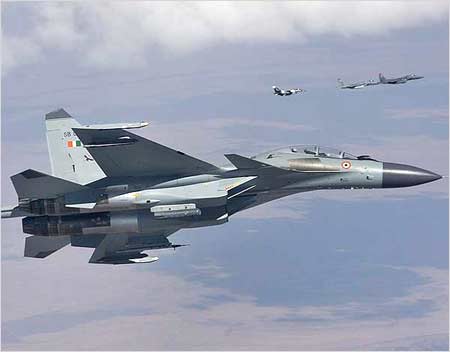
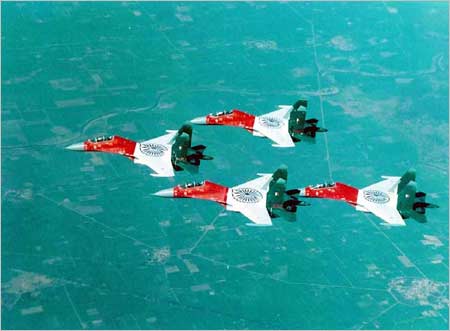
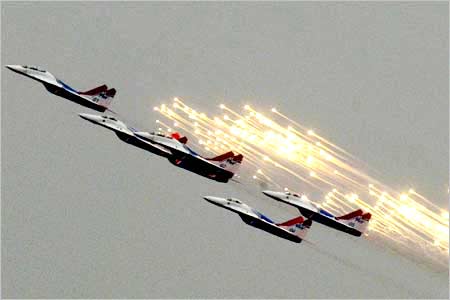
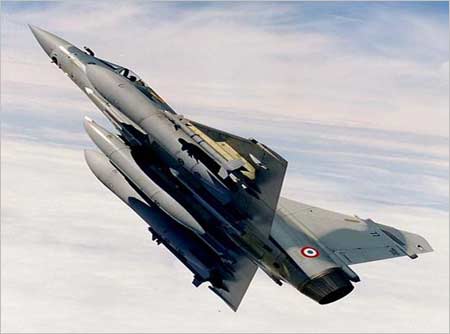

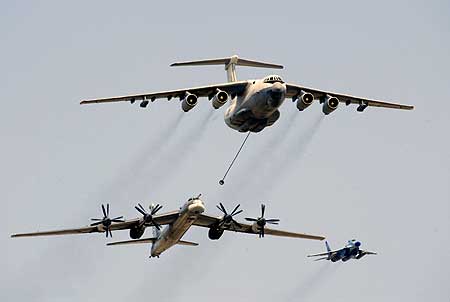

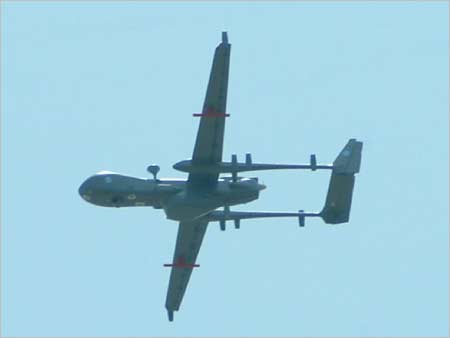
article